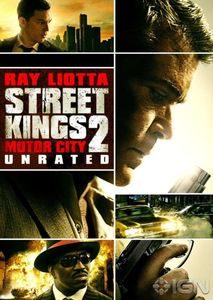Street Kings 2: Motor City (2011)
(On DVD, December 2011) The trend toward “cheap but effective direct-to-video sequels related to their predecessor except in title only” continues with this follow-up to 2008’s corrupt-cop drama. The only constant here is the theme of police corruption, as the action moves to Detroit (just like S.W.A.T.2: Fireight, in fact) and features an entirely different cast of character. Ray Liotta headlines the picture as an aging police veteran, but the picture eventually revolves around Shawn Hatosy as an eager young cop trying to piece together the truth behind a few deaths in the police force. It doesn’t turn out cheerfully, especially given what he has to lose. The bleak conclusion is one of Motor City’s low points, but it caps a fairly average effort that seem well in-line with many recent direct-to-video thriller “sequels”. The visual polish of the digitally-shot film is up to most standards, with a few directorial flourishes by DTV veteran Chris Fisher and stylistic touches that are a bit more ambitious that what the picture strictly needed. Detroit, in its lapsed glory, has a large presence as the setting of the picture and this influences leads to some interesting choices as the film focuses on American muscle-car cinematography. It’s a bit of a shame, then, that the familiar story deflates a bit after a promising first half: By the time the third act descends in increasing nihilism and abrupt ending, it’s unclear why, Motor City needs to be told or watched if it’s going to be so bleakly routine without any other redeeming qualities. At least the film itself struggles to a certain level of competence, even though it doesn’t really know what to do once it has covered most of the basic requirements of an acceptable film. The recent revival of DTV films to a level of quality roughly equal to the lower-tier of theatrical features is a welcome improvement over the historical standard, but there’s still a way to go before fully erasing the DTV stigma; it will start once the stories are just as interesting as what we can pay to see in theatres. The DVD contains a large number of extra features that, by letting its filmmakers speak, make Motor City appear more pretentious than if you’d just watched the feature alone.

